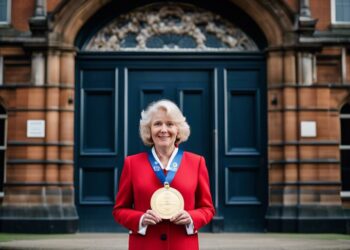Emblazoned with rich hues and intricate details, the work of stained glass artist Brian Clarke has captured the attention of the world. You may be surprised to learn that this esteemed artist, at the age of 70, has been honored with a knighthood in the New Year Honours for his exceptional contributions to the world of art over the span of more than 50 years. Clarke’s masterful creations have graced landmarks such as the Al Faisaliyah Center in Riyadh, the Royal Mosque of King Khalid International Airport in Saudi Arabia, and the 14-metre-high, stained glass pavilion, The Stamford Cone in Connecticut. His dedication to beautifying the world through his art has earned him this prestigious honor, as well as the gratitude and admiration of admirers from all corners of the globe.

Brian Clarke’s Legacy
Your Sir Brian Clarke’s legacy as a renowned stained glass artist has left an indelible mark on the art world, with a career spanning over 50 years and an extensive portfolio of prestigious works and commissions.
Early Life and Career Beginnings
Your journey as a stained glass artist started from humble beginnings in Oldham, where you honed your craft and developed a deep appreciation for the art form. Your early experiences and exposure to the working class community shaped your artistic vision, laying the foundation for your future contributions to the art world.
Notable Works and Commissions
Throughout your illustrious career, you have created awe-inspiring stained glass pieces that have adorned landmark buildings and structures around the world. From the Al Faisaliyah Center in Riyadh to the Brian Clarke Church of England Academy in Oldham, your work has left an indelible mark on the architectural landscape, captivating audiences with its beauty and intricacy.
Clarke’s Influence on Contemporary Art
Your innovative approach to stained glass art has significantly influenced the contemporary art scene, challenging traditional norms and pushing the boundaries of the medium. Your unique style and creative vision have inspired a new generation of artists, leaving an enduring impact on the world of art and design.
Contributions to the Community
Besides your artistic achievements, you have also made significant contributions to the community through your work. The creation of the stained glass windows for the Brian Clarke Church of England Academy stands as a testament to your commitment to enriching the lives of others through art, leaving a lasting legacy for future generations to admire and appreciate.
The Knighthood
For his services to art in a career spanning over 50 years, stained glass artist Brian Clarke has been awarded a knighthood in the New Year Honours, a recognition that has left him feeling surprised and grateful. Clarke, known for his iconic stained glass designs featured in landmarks across the globe, expressed his gratitude for the honour and the acknowledgment of his life’s work.
Clarke’s Reaction to the Honour
Upon receiving the knighthood, Clarke expressed feeling grateful and surprised. He believes that his art is for the working class and is intended to beautify the spaces it occupies. The recognition of his work through this knighthood has been more than he could have imagined, and he sees it as contributing to the support and continuation of a unique and special part of our visual arts culture.
Significance of a Knighthood in the Arts
The award of a knighthood to a stained glass artist like Brian Clarke is significant in the arts community as it highlights the importance of diverse and innovative artistic expressions. It serves as a testament to the impact of Clarke’s work and its contribution to the visual arts culture. His knighthood not only recognizes his individual achievements but also elevates the status and recognition of stained glass art in the broader artistic landscape.
Public and Peer Responses
The public and peer responses to Clarke’s knighthood have been overwhelmingly positive. The recognition of his artistic contributions has led to widespread celebration and acknowledgment of his talent and dedication. Fellow artists, art enthusiasts, and the general public have applauded the honour bestowed upon Clarke, emphasizing the significance of his work and its lasting impact on the arts.
The Art of Stained Glass
Despite being one of the oldest forms of art, stained glass continues to captivate and inspire viewers with its vibrant colors and intricate designs. The art of creating stained glass windows dates back to medieval times, where it was used to convey stories and religious symbolism in churches and cathedrals. Today, stained glass art has evolved into a diverse form of expression, encompassing both traditional and contemporary styles.
Historical Context of Stained Glass Art
Stained glass art has a rich historical context, with its origins dating back to the 7th century. During the medieval period, stained glass windows were not only a form of decoration but also served as a means of storytelling for the illiterate masses. These windows depicted biblical scenes, saints, and religious motifs, serving as a visual narrative of religious teachings. The craftsmanship and artistry involved in creating these windows were highly esteemed, and many of these historical pieces still stand today, showcasing the enduring nature of stained glass art.
Modern Evolutions in Stained Glass Technology
In modern times, stained glass technology has seen significant advancements, allowing artists to explore new techniques and materials. The incorporation of modern technologies such as computer-aided design and digital printing has expanded the creative possibilities for stained glass artists. These innovations have enabled artists to push the boundaries of traditional stained glass art, creating contemporary pieces that blend historical techniques with modern aesthetics.
Educational Impact and the Brian Clarke Church of England Academy
The educational impact of stained glass art is evident in institutions such as the Brian Clarke Church of England Academy, where the art form is celebrated and taught to the next generation of artists. Brian Clarke’s contribution to the academy reflects the positive impact of art education, providing aspiring artists with the knowledge and skills to carry on the legacy of stained glass art. The academy’s focus on preserving and advancing the art form ensures that stained glass continues to thrive as a unique and special part of our visual arts culture.
Reflections on Art and Culture
Now, let’s reflect on the impact of art and culture on society and the significance of recognizing artists like Brian Clarke. Art and culture are essential elements of our society that shape our identities, beliefs, and values. They reflect the history, traditions, and beliefs of a particular community, and in doing so, they contribute to the preservation and celebration of our cultural heritage.
Stained Glass as Cultural Heritage
Stained glass has a long-standing tradition in cultural heritage, dating back to the Middle Ages. It has been used to depict religious narratives, historical events, and symbolic representations of the human experience. The intricate craftsmanship and vibrant colors of stained glass windows have the power to transport you to a different time and place, offering a unique lens through which to appreciate the stories and beliefs of our ancestors.
Clarke’s Perspective on Art for the Working Class
One of the most remarkable aspects of Brian Clarke’s art is his commitment to creating work that resonates with the working class. He believes that art should be accessible to all and that it has the power to inspire, uplift, and empower individuals from all walks of life. His dedication to producing art that speaks to the experiences of ordinary people is a testament to the transformative potential of art in shaping society.
The Role of Art in Beautifying Public Spaces
Brian Clarke’s work has left an indelible mark on public spaces around the world, demonstrating the vital role of art in enhancing the aesthetic appeal of our surroundings. His stained glass creations have adorned iconic landmarks, adding a sense of beauty, depth, and cultural significance to these spaces. By integrating art into public environments, Clarke has shown the profound impact it can have on our collective experience, cultivating a sense of pride and identity in our communities.
Conclusion
Drawing together the recognition and appreciation of a lifetime dedicated to art and beauty, Brian Clarke’s knighthood in the New Year Honours is a testament to his talent and contribution to the visual arts culture. His stained glass work, known for gracing iconic landmarks worldwide, is a testament to his dedication and creativity. As he humbly accepts the honor, you can’t help but acknowledge the profound impact of his art on the world and the inspiration it provides to aspiring artists. Brian Clarke’s knighthood is a reminder of the transformative power of art and the enduring legacy it creates.










